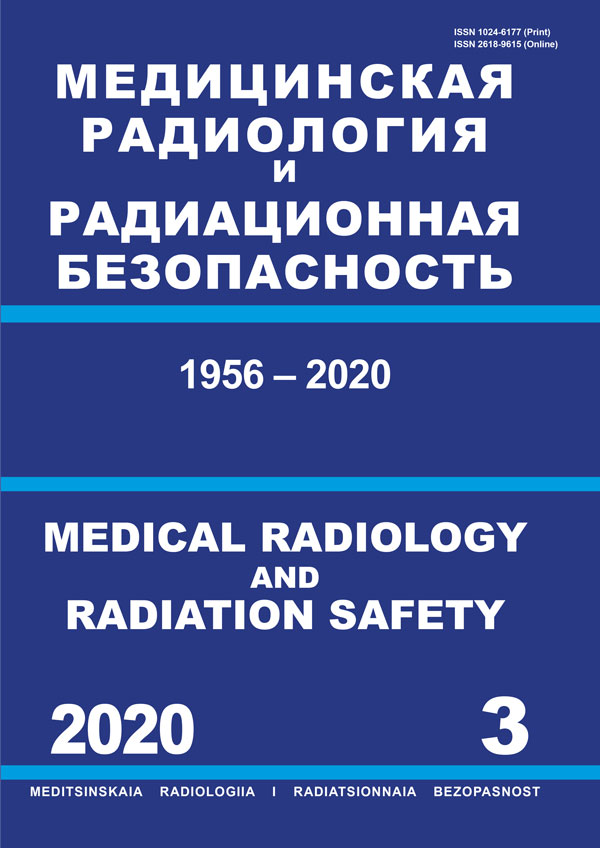Russian Federation
Russian Federation
Russian Federation
Russian Federation
CSCSTI 76.03
CSCSTI 76.33
Russian Classification of Professions by Education 14.04.02
Russian Classification of Professions by Education 31.06.2001
Russian Classification of Professions by Education 31.08.08
Russian Classification of Professions by Education 32.08.12
Russian Library and Bibliographic Classification 51
Russian Library and Bibliographic Classification 534
Russian Trade and Bibliographic Classification 5708
Russian Trade and Bibliographic Classification 5712
Russian Trade and Bibliographic Classification 5734
Russian Trade and Bibliographic Classification 6212
Purpose: To optimize the computed tomography protocol in pediatric Hodgkin lymphoma for radiation dose reduction by reducing the scanning phases. Material and methods: A retrospective CT scan analysis of 48 children with newly diagnosed, verified Hodgkin’s lymphoma was performed at the primary staging and after the first chemotherapy. All studies were performed with contrast enhancement, scanning on a 16-slice computed tomography in the precontrast, arterial, venous and delayed phases. The radiation dose and the diagnostic value of each phase were assessed. Results: Two-phase scanning (in the native and venous phases) for primary patients allows significantly reduce the cumulative effective dose (ED) almost in twofold. Conducting single-phase scanning can significantly reduce the received ED by 3.8 times in both the primary and dynamic studies. Using the abbreviated protocol does not reduce the diagnostic value of CT. Conclusion: The greatest number of repeated CT examination is carried out in children with lymphomas. The radiation dose increases several times in multiphase scanning. New CT protocols reduces the radiation dose on children with Hodgkin lymphoma.
computed tomography, radiation dose, children, radiation safety, Hodgkin’s lymphoma, multiphase scanning
1. Berrington De Gonzalex A, Darby S. Risk of cancer from diagnostic X-rays: estimates for the UK and 14 other countries. Lancet. 2004;363:345-51. DOI:https://doi.org/10.1016/S0140-6736(04)15433-0.
2. Krille L, Zeeb H, Jahnen A, et al. Computed tomographies and cancer risk in children: a literature overview of CT practices, risk estimations and an epidemiologic cohort study proposal. Radiation and Enviromental Biophysics. 2012;51:103-1. DOI:https://doi.org/10.1007/s00411-012-0405-1.
3. Voss SD, Chen L, Constine LS, et al. Surveillance computed tomography imaging and detection of relapse in intermediate- and advanced-stage pediatric Hodgkin’s lymphoma: a report from the children’s oncology group. J Clin Oncol. 2012;30:2635-40. DOI:https://doi.org/10.1200/JCO.2011.40.7841
4. Ansell MS, Stephen M. Hodgkin lymphoma-diagnosis and treatment. Mayo Clinic Proc. 2015;90(11):1574-83. https://doi.org/10.1016/j.mayocp.2015.07.005
5. Thomas KE, Wang B. Age-specific effective doses for pediatric MSCT examinations at a large children’s hospital using DLP conversion coefficients: a simple estimation method. Pediatr Radiol. 2008;38:645-656. DOI:https://doi.org/10.1007/s00247-008-0794-0
6. Vock P. CT radiation exposure in children: Consequences of the American discussion for Europe. Radiologe. 2002;42:697-702. DOI:https://doi.org/10.1007/s00117-002-0812-4
7. Strauss KJ, Goske MJ, Kaste SC, et al. Image gently: ten steps you can take to optimize image quality and lower CT dose for pediatric patients. Amer J Roentgenol 2010;194(4):868-73. DOI:https://doi.org/10.2214/AJR.09.4091
8. Chan M.G., Cassidy F.H., Andre M.P. Imaging in routine CT examinations of the abdomen and pelvis: Is it worth the additional cost of radiation and time? Amer J Roentgenol 2014;202:329-335. DOI:https://doi.org/10.2214/AJR.12.10468
9. Yoshida K., Krille L., Dreger S. et al. Pediatric computed tomography practice in Japanese university hospitals from 2008-2010: did it differ from German practice? // J Radiat Res. 2016; P. 1-7. DOI: https://doi.org/10.1093/jrr/rrw074
10. Methodological instructive regulations 2.6.1.2944-11. Control of effective radiation doses of patients during medical X-ray studies; - Rospotrebnadzor, 2011 http://docs.cntd.ru/document/1200092857. (Russian).
11. Decree of the Chief State Sanitary Doctor of the Russian Federation No. 40 dated April 26, 2010 (Edited on September 16, 2013) “On approval of SP 2.6.1.2612-10 Basic Sanitary Rules for Ensuring Radiation Safety (OSPORB-99/2010)”. (Russian).
12. Yu T, Gao J, Liu ZM, et al. Contrast dose and radiation dose reduction in abdominal enhanced computerized tomography scans with single-phase dual-energy spectral computerized tomography mode for children with solid tumors. Chinese Medical Journal. 2017;130(7):823-31. DOI:https://doi.org/10.4103/0366-6999.202731.
13. Sinitsyn VE, Glazkova MA, Mershina EA, Arhipova IM. Possibilities of decreasing radiation doses during MSRT coronarography: using adaptive statistic iterative reconstruction. Angiology and Vascular Surgery. 2012;18(3):44-8. (Russian).
14. Blinov AB, Blinov NN. Radiation doses in X-ray computed tomography. Medical technology. 2010;5(263):23-5. http://mtjournal.ru/upload/iblock/7bb/7bbc77c447bf48351d3a79bbe44bdd06.pdf
15. McCollough CH, Primak AN, Braun N. et al. Strategies for reducing radiation dose in CT. Radiologic Clinics of North America, 2009;47(1):27-40. DOI:https://doi.org/10.1016/j.rcl.2008.10.006
16. Gombolevskii VA, Kotlyarov PM, Dacenko PV, Nudnov NV. Low dose CT protocol in Hodgkin’s lymphoma. RNCCR RF 2013;(13) (Russian). http://vestnik.rnc rr.ru/vestnik/v13/pape rs/gombolevskii_v13.html.





